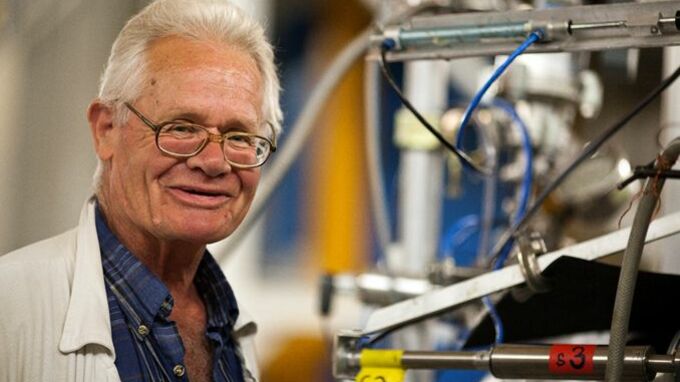Trauer um Wegbereiter der ultrakalten Neutronen
Prof. Dr. Albert Steyerl wirkte lange am FRM und am Physik-Department
2020-05-25 – Nachrichten aus dem Physik-Department

Schon im Gymnasium seines Geburtsorts München verpassten ihm die Mitschüler wegen seiner Rechenkünste den Spitznamen „EinSteyerl“, berichtet sein späterer Doktorand Dr. Erwin Gutsmiedl von der Technischen Universität München. Nach dem Maschinenbaustudium an der damals Technischen Hochschule München zog der 24-jährige Albert Steyerl an das Massachusetts Institute of Technology (MIT) in die USA und promovierte dort im Maschinenbau. Am MIT lernte er seine spätere Ehefrau Nagako kennen, die er 1966, zurück in München, heiratete. Drei Kinder bekam das Paar: Ken, Hito und Anton.
Mit Steyerl-Turbine Neutronen in Flaschen speichern

Beruflich ging es für Albert Steyerl nach Garching zum damals bereits berühmten Heinz Maier-Leibnitz. Albert Steyerl wurde sein Doktorand und Maier-Leibnitz war klug genug, den Maschinenbauer Steyerl auf ein bis dato ungelöstes Problem der Kernphysik anzusetzen: schnelle Neutronen aus der Kernspaltung so abzubremsen, dass man sie in Flaschen sperren und die Kernteilchen selbst untersuchen kann. Zwei Lösungsansätze verfolgte und baute Steyerl am Atom-Ei in Garching: Ein 13 Meter langes, senkrecht in die Höhe laufendes Strahlrohr nach der Idee von Maier-Leibnitz. Hier sollten die Neutronen in der Höhe an Geschwindigkeit verlieren.
Die zweite Idee, die der findige Albert Steyerl selbst ertüftelte, führte schließlich zum Durchbruch. Er entwickelte eine Neutronenturbine, die mit Schaufeln die schnellen Neutronen abbremste. Für diese Erfindung erhielt der 36-Jährige 1974 den Physikpreis der Deutschen Physikalischen Gesellschaft und habilitierte sich gleichzeitig an der TU München.
Spektakulär war nicht nur die fortan unter Kollegen „Steyerl-Turbine“ genannte Apparatur, sondern auch die Messungen, die Steyerl damit am Atom-Ei erstmalig ermöglichte: Er speicherte die kurzlebigen Neutronen in einer Flasche. Dies erlaubte lange Beobachtungszeiten und somit Messungen grundlegender Eigenschaften des Neutrons in zuvor unerreichter Genauigkeit. Steyerl wurde Professor am Physik-Lehrstuhl E21 der TU München. Um seine Studenten kümmerte er sich aufopfernd. „Albert Steyerl war einer vom alten Schlag: Er konnte gut rechnen und hatte ein Gespür für Experimente“, so Gutsmiedl.
Lebensdauer des Neutrons auf eine Sekunde genau bestimmt

Seine Erfindung perfektionierte er 1984 in der Neutronenturbine am Hochflussreaktor des Institut Laue-Langevin in Grenoble, Frankreich. Die Steyerl-Turbine in Grenoble war mehr als ein Vierteljahrhundert das Mekka der Forschung mit ultrakalten Neutronen und ist auch heute noch konkurrenzfähig. Wissenschaftler führten hier bahnbrechende Grundlagenexperimente durch, wie die Suche nach einem elektrischen Dipolmoment des Neutrons und Messungen der Lebensdauer eines Neutrons mit einer Genauigkeit von einer Sekunde.
Als Steyerl 1988 mit seiner Frau und seinem jüngsten Sohn in die USA zog und Physik-Professor an der University of Rhode Island wurde, war er bereits international einer der anerkannten „Päpste für ultrakalte Neutronen“, so Gutsmiedl.
Buch und letzte Publikation erscheinen posthum
2019 erfuhr er von seiner schweren Krankheit. Statt sich zurückzuziehen, plante er seine letzten Monate, um noch möglichst viel zu erledigen, berichtet Sohn Ken Steyerl. Albert Steyerl vollendete sein Buch „Ultracold Neutrons“, das nun posthum im Juni erscheinen wird, ebenso wie eine Publikation zu ultrakalten Neutronen in magnetischen Flaschen, die er vier Wochen vor seinem Tod noch eingereicht hat.
Zusammen mit mehr als 150 Wissenschaftlern, Ingenieuren und Technikern sprach Dr. Peter Geltenbort, 27 Jahre lang Verantwortlicher der Steyerl-Turbine am ILL, in einem Kondolenzbrief der Familie sein Beileid aus: „Die Nachricht vom Tode Ihres Mannes und Vaters hat uns Forscher mit ultrakalten Neutronen rund um den Globus getroffen und berührt. Albert wird unserer Gemeinschaft fehlen, aber wir werden sein Andenken in Ehren halten und sein Erbe pflegen.“
- Redaktion
- FRM II / TUM
